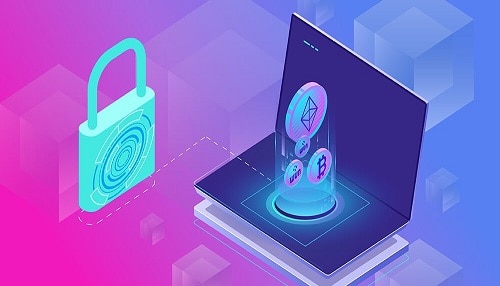How To Keep Your Cryptocurrency Secure

When it comes to crypto security, a lot depends on the behaviors of the individual. When it comes to how much money you may earn from investing in cryptocurrency, the importance of maintaining your own personal safety cannot be overstated. Even though blockchain technology itself is intended to provide an exceptionally high level of protection, and even though a blockchain database is exceedingly difficult to penetrate via hacking, human error and physical threats may still occur.
Here are some of the ways to keep your cryptocurrency secure:
- Take basic Internet security measures.
- Use strong, updated passwords.
- Don’t visit suspicious sites or click on suspicious links.
- Don’t use “free WiFi”.
- Use Internet security tools like antivirus programs and VPNs.
- Activate 2-factor authentication for all your accounts.
2 Factor Authentication (2FA):
– Enable on everything possible (Email, Exchanges, Banks, even Reddit to protect your moons)
– Use 2FA Apps instead of SMS whenever possible, SIM Swap attacks are real, and more common than you think.
2FA Apps
Authy (Linux | Windows | macOS | Iphone | Android)
Google Authenticator (iOS | Android)
Microsoft Authenticator ( iOS | Android)
LastPass Authenticator (Browser Extension | iOS | Android | Windows Phone)
Hardware Keys
These are physical 2FA devices (article was chosen because it does a good job explaining the concept with pros and cons, we did not vet the sellers that are listed on the Amazon links. Always research and buy from a reliable source)
Hardware Wallets
Unlike software wallets, hardware wallets store your private keys on an external device like USB. They are entirely cold and secure. Also, they are capable of making online payments, too. Some hardware wallets are compatible with web interfaces and support multiple currencies. They are designed to make transactions easy and convenient, so all you need to do is plug it in any online device, unlock your wallet, send currency, and confirm a transaction. Hardware wallets are considered the safest means of storing crypto assets. The only drawback is that they aren’t free to use.
Popular hardware wallets include devices by:
Backup codes:
When you activate 2FA on any account you should have the ability to generate backup codes, these are used incase you lose access to your authenticator, TREAT these like your seed phrases. Use them by logging in with your user and pass, and use these backup codes in place of the 2FA code you usually enter.
- DO NOT take pictures of your QR codes, if you screenshot it might end up syncing somewhere you don’t want it to and if it ever gets compromised they have the ability to continually receive your 2FA code.
- DO NOT sign up for your 2FA app or any crypto service for that matter using your work or school email address. If you lose access to that email, then consider all accounts gone as you won’t be able to access the codes if you switch devices.
Keep in mind that you are the weakest link in the chain. The process of actually hacking the code of a blockchain or getting past the security system of a website is very complex and needs specific expertise that the vast majority of criminals do not possess. It is far simpler for a thief to pose as a reliable third party or to offer you links to websites that have been hacked in the expectation that you would click on them.
Always use caution, and verify information by looking it over again once you get a message. By exercising caution, you may avoid falling victim to shady cryptocurrency advocates, sketchy exchanges that might close at any moment, phishing emails and texts, and other similar scams. Make an informed decision on the websites and shops from which you download software and applications. Official websites and stores, such as Apple’s App Store, may be a good option, while the Google Play Store has been recognized as a significant source of malicious software for Android. If you are trying to access or download anything, and a reminder appears, read the reminder, and then reconsider whether you still want to access or download whatever it was that you had meant to do in the first place.
In light of the many frauds and dangers described above, storing your cryptocurrency assets in a cold storage hardware wallet, such as a Trezor or a Ledger Nano S, is still the most secure course of action. If your digital wallet is cut off from the Internet, it will be impossible for hackers to access it in any direct way. Hackers will not be able to get access to your private key even if you fall victim to phishing or download a malware and then use your Trezor or Ledger Nano on a computer that has been hacked. This is because your private key is encrypted. The only method to break into a hardware wallet is to physically obtain control of it (via theft, deceit, or robbery) and also get the PIN number to activate it. This is the only way to compromise the security of a hardware wallet.
You will need to generate a BRAND NEW SEED when you are initially setting up your hardware wallet for the very first time.
If you skipped this step during the setup process, there is a chance that someone else performed it behind your back in the hopes that you wouldn’t notice.
After that, they will keep an eye on your wallet for any transactions and subsequently empty it.
Every wallet has a method for creating your seed, after which it will show it to you so that you may write it down. This applies to each and every kind of wallet, so if you haven’t done any of these things, you need to start looking into it right now since your money might be at danger.
It is time to delete all of the data on your smartphone after you have successfully installed and configured your new wallet and written down your seed.
Indeed, we can’t avoid doing this.
You should do a factory reset on your device and then recover it using your seed before sending even a single transaction to your new address. This guarantees that you have accurately recorded your seed and that you will be able to restore your wallet in the event that it is lost, stolen, or destroyed.
Common Cryptocurrency Scams
As a means of assisting you in avoiding falling victim to con artists, the following provides a description of the most common crypto coin scams as well as the typical “modus operandi” of crypto scammers. This will enable you to safeguard yourself when navigating the largely unregulated and still immature waters of the cryptocurrency market.
Key-Stealing Malware
A key-stealing malware scans the hard drive of your computer or mobile device for your crypto private keys. You put your device at risk of being infected with malware that steals your keys if you go to sketchy websites, click on links sent to you by con artists, open insecure attachments to emails, or download software from unreliable sources. When you download malicious software that steals keys on your computer or mobile device, the software immediately begins searching your hard drives for your cryptographic private keys and then sends those keys to an attacker. The person controlling the malware will now have access to your accounts and will be able to transfer your holdings in a matter of seconds if you do not secure your crypto wallets with two-factor authentication in addition to the key. If you do not secure your crypto wallets with two-factor authentication, the malware’s controller will gain access to your accounts.
Trojan
Another kind of virus that steals cryptocurrency is known as a trojan. Your coins are not “stolen” by Trojans; rather, they search through your hard drives to determine the precise value of your cryptocurrency holdings. After that, they encrypt your hard drives in a malicious manner and demand a ransom by sending you emails and displaying messages on your screen. Even well-protected exchanges run the risk of being infected by ransomware. When consumers are faced with a predicament in which the ransomware threatens to format their hard drives if the ransom is not paid within a specified amount of time, they often have no other choice than to pay the extortion.
Exit Scam
When exchanges, middlemen, or managers take investors’ money and vanish without a trace, this is known as an exit scam. It is a modern take on an age-old confidence trick that has been used for ages, but with a cryptographic twist. In the past, it was not uncommon for fund managers or the founders of startups to abscond with the money invested in them. In the cryptocurrency sector, exchanges have the risk of disappearing with the deposits of their customers, and the managers or owners of cryptocurrency projects carry the risk of absconding with the monies gathered from an initial coin offering (ICO). When compared to more conventional forms of fraud, crypto scams may be more difficult to track down and recover monies from because of the decentralized and anonymous nature of the crypto world, as well as the limited legal frameworks that exist for it. There have been other instances of exit frauds recently, including Confido in 2017, LoopX in 2018, and Yfdex in 2020. Before making any investments in cryptocurrencies, users need to educate themselves on how to identify any frauds.
Phishing
Phishing scams are often carried out via electronic communication channels like email, texting, or social media. You could get a message or an email asking you to do certain activities, such as giving your authentication code, password, credit card information, or other credentials. These requests might come in the form of phishing scams. The email, on the other hand, is not authentic and seems to be an effort to impersonate another individual. Your cryptocurrency assets are at risk if you respond to those phishing emails and provide any information to the scammers asking for it.
Device Loss
There is, after all, the tried-and-true method of squandering one’s possessions, which is to really misplace one’s mobile gadgets (or laptops). Unlocking your device is something that may be attempted by anybody who comes into possession of it, whether they discover it or steal it. If they are successful in unlocking your smartphone, they will be able to access your cryptocurrency holdings that are kept in the wallets on that device, as well as your accounts for fiat currency, emails, passwords, social media accounts, and anything else of value that is linked to your device.





















